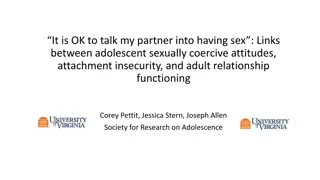
US Biosimilars Draft Guidance by Dr. Jay P. Siegel
Explore select topics from US Biosimilars Draft Guidances presented by Dr. Jay P. Siegel, delving into biosimilarity standards, avoidable differences, interchangeability concerns, and extrapolation of indications. Gain insights into how intentional differences in biologics are managed and the challenges of establishing interchangeability between reference products and biosimilars.
Download Presentation

Please find below an Image/Link to download the presentation.
The content on the website is provided AS IS for your information and personal use only. It may not be sold, licensed, or shared on other websites without obtaining consent from the author. If you encounter any issues during the download, it is possible that the publisher has removed the file from their server.
You are allowed to download the files provided on this website for personal or commercial use, subject to the condition that they are used lawfully. All files are the property of their respective owners.
The content on the website is provided AS IS for your information and personal use only. It may not be sold, licensed, or shared on other websites without obtaining consent from the author.
E N D
Presentation Transcript
Select Topics Regarding US Biosimilars Draft Guidances Jay P. Siegel, MD Chief Biotechnology Officer Head of Global Regulatory Affairs Janssen R&D
Select Topics Regarding US Biosimilars Draft Guidances Biosimilarity Standard Interchangeability Extrapolation of Indications 2
Biosimilarity Standard: Avoidable Differences All product differences carry risk of clinically meaningful differences. For biologics, some differences cannot be avoided or cannot be avoided with reasonable practicality. Therefore . . . We have biosimilars rather than generics. FDA has provided draft guidance on how to control and minimize those risks. Other, avoidable differences expose patients to avoidable risk. Not all implications of differences can be predicted. Excipients, impurities, and containers can impact product performance in unanticipated ways. For example, removal of albumen from erythropoietin formulations (at the request of regulators) led to emergence of Pure Red Cell Aplasia. There is a time tested BLA pathway for intentionally different biologics. 3
Avoidable Differences The draft guidance contemplates allowing various types of intentional, avoidable differences in the product. We urge the FDA: To indicate that reasonably avoidable differences in the active pharmaceutical ingredient must be avoided. To indicate that other reasonably avoidable differences should be avoided. To note that excipients, impurities, and containers are not necessarily clinically inactive components and can interact with the principle component in many, clinically important ways. To avoid (mis)characterizing removal of HSA as a minor difference in a clinically inactive component. To make clear that the biosimilars pathway is not appropriate for intentionally improved products and that claims of being better will not be permitted. 4
Interchangeability Switching patients between a reference product and a safe and effective biosimilar raises additional concerns, e.g., Potential additive, cross-reactive immunogenicity Dosing adjustments Tracing problems The law sets an appropriately high standard for interchangeability. We agree with the guidance that at this time, it would be difficult as a scientific matter to establish interchangeability in an original 351(k) application given the statutory standard. We urge the FDA: To protect patients by upholding the interchangeability standard with scientific rigor. To ensure that naming and packaging maximize the ability to trace events to specific products. 5
Extrapolation of Indications There are many reasons why differences between a biosimilar and a reference product may not manifest in one indication but may be clinically meaningful in another. We urge the FDA to promote the following principle for patient protection: Clinical testing to exclude differences should be done in a setting sensitive to such differences. We also urge the FDA to give a more comprehensive list of the types of factors that may impact such sensitivity including: Immunosuppression Underlying disease Concomitant medications Susceptibility to adverse effects, immune competence Dose, regimen, route 6






















